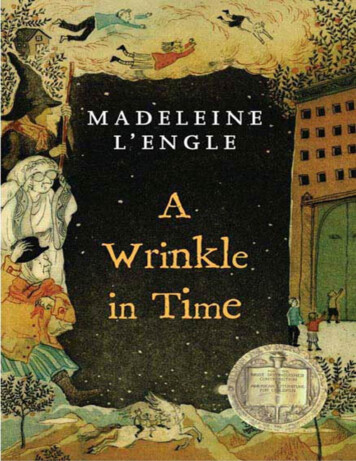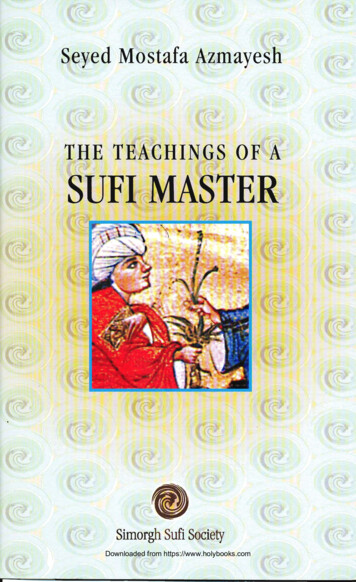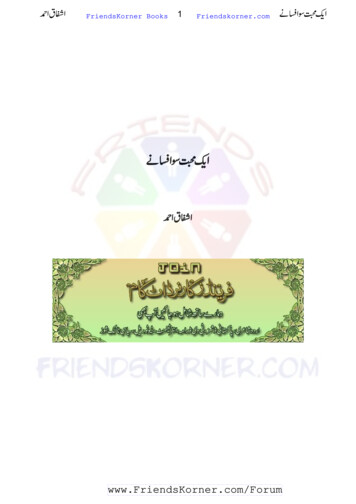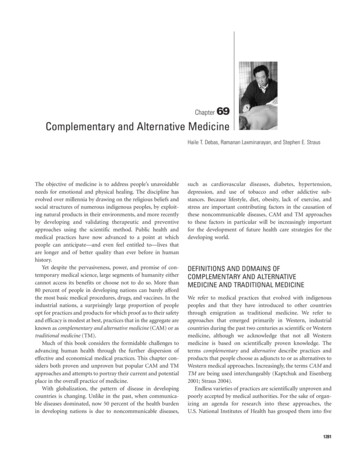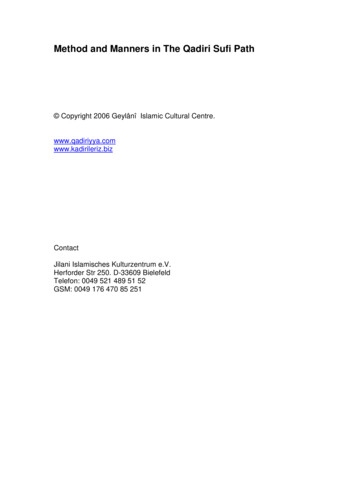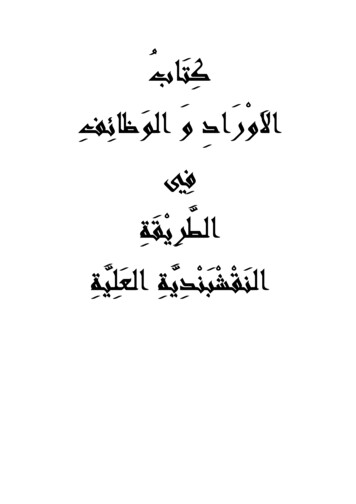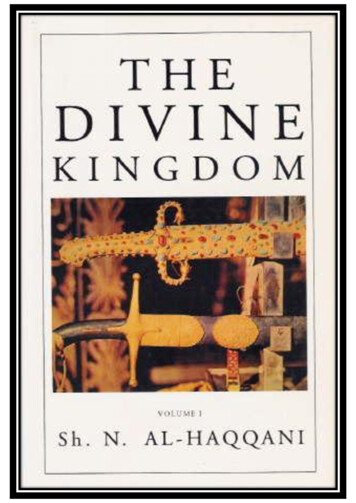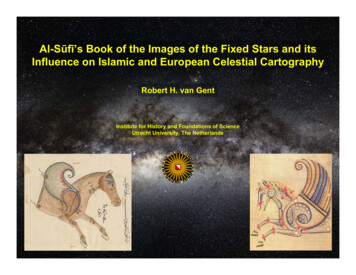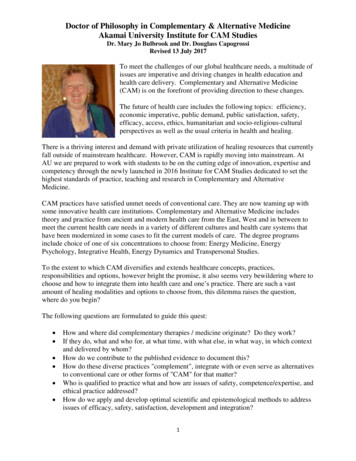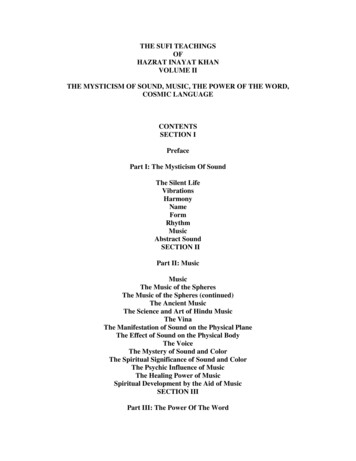
Transcription
THE SUFI TEACHINGSOFHAZRAT INAYAT KHANVOLUME IITHE MYSTICISM OF SOUND, MUSIC, THE POWER OF THE WORD,COSMIC LANGUAGECONTENTSSECTION IPrefacePart I: The Mysticism Of SoundThe Silent LifeVibrationsHarmonyNameFormRhythmMusicAbstract SoundSECTION IIPart II: MusicMusicThe Music of the SpheresThe Music of the Spheres (continued)The Ancient MusicThe Science and Art of Hindu MusicThe VinaThe Manifestation of Sound on the Physical PlaneThe Effect of Sound on the Physical BodyThe VoiceThe Mystery of Sound and ColorThe Spiritual Significance of Sound and ColorThe Psychic Influence of MusicThe Healing Power of MusicSpiritual Development by the Aid of MusicSECTION IIIPart III: The Power Of The Word
The Power of the WordThe Power of the Word (continued)The Power of the Word (continued)The Power of the Word (continued)The Power of the Word (continued)The Word that was LostCosmic LanguageSECTION IVPart IV: Cosmic LanguageVoicesVoices (continued)ImpressionsThe Magnetism of Beings and ObjectsThe Influence of Works of ArtThe Life of ThoughtThought and ImaginationMemoryWillReasonThe EgoMind and HeartIntuitionInspirationTHE SUFI TEACHINGSOFHAZRAT INAYAT KHANVOLUME IITHE MYSTICISM OF SOUND, MUSIC, THE POWER OF THE WORD, COSMICLANGUAGEPrefaceIn this volume, the second of The Sufi Message of Hazrat Inayat Khan, an attempt eachingconcerningsoundandmusic - sound as the basis of creation and music as an essential means towards spiritualdevelopment.Having been a musician of renown before he gave up his art in order to dedicate himselfentirely to the Sufi Message with which he was entrusted, Inayat Khan readily followed
the practice of the ancient Sufis in expressing esoteric truths in terms of sound and music.He once described this as follows:I gave up my music because I had received from it all that I had to receive. To serve Godone must sacrifice what is dearest to one; and so I sacrificed my music. I had composedsongs; I sang and played the vina; and practicing this music I arrived at a stage where Itouched the Music of the Spheres. Then every soul became for me a musical note, and alllife became music. Inspired by it I spoke to the people, and those who were attracted bymy words listened to the, instead of listening to my songs. Now, if I do anything, it is totune souls instead of instruments; to harmonize people instead of notes. If there isanything in my philosophy, it is the law of harmony: that one must put oneself inharmony with oneself and with others. I have found in every word a certain musicalvalue, a melody in every thought, harmony in every feeling; and I have tried to interpretthe same thing, with clear and simple words, to those who used to listen to my music. Iplayed the vina until my heart turned into this very instrument; then I offered thisinstrument to the divine Musician, the only musician existing. Since then I have becomeHis flute; and when He chooses, He plays His music. The people give me credit for thismusic, which in reality is not due to me but to the Musician who plays on his owninstrument.’Of the four books included in this volume The Mysticism of Sound was first published in1923 and Cosmic Language in 1937. They consist of lectures given by Hazrat InayatKhan to his pupils. Music is the title of a hitherto unpublished series of lectures of 1921,to which have been added some other papers on the same subject. Under the heading ThePower of the Word have been grouped several public lectures bearing that title, atwasLost’and‘CosmicLanguage’,theformer of which was published in the quarterly Sufism of September 1923.PART ITHE MYSTICISM OF SOUNDCHAPTER ITHE SILENT LIFEThe Life Absolute from which has sprung all that is felt, seen, and perceived, and intowhich all again merges in time, is a silent, motionless and eternal life which among theSufis is called Zat. Every motion that springs forth from this silent life is a vibration and acreator of vibrations. Within one vibration are created many vibrations; as motion causesmotion so the silent life becomes active in a certain part, and creates every moment moreand more activity, losing thereby the peace of the original silent life. It is the grade ofactivity of these vibrations that accounts for the various planes of existence. These planesare imagined to differ from one another, but in reality they cannot be entirely detached
and made separate from one another. The activity of vibrations makes them grosser, andthus the earth is born of the heavens.The mineral, vegetable, animal and human kingdoms are the gradual changes ofvibrations, and the vibrations of each plane differ from one another in their weight,breadth, length, color, effect, sound and rhythm. Man is not only formed of vibrations,but he lives and moves in them; they surround him as the fish is surrounded by water, andhe contains them within him as the tank contains water. His different moods, inclinations,affairs, successes and failures, and all conditions of life depend upon a certain activity ofvibrations, whether these be thoughts, emotions or feelings. It is the direction of theactivity of vibrations that accounts for the variety of things and beings. This vibratoryactivity is the basis of sensation and the source of all pleasure and pain; its cessation isthe opposite of sensation. All sensations are caused by a certain grade of activity ofvibration.There are two aspects of vibrations, fine and gross, both containing varied degrees; someare perceived by the soul, some by the mind, and some by the eyes. What the soulperceives are the vibrations of the feelings; what the mind conceives are the vibrations ofthe thoughts; what the eyes see are the vibrations solidified from their ethereal state andturned into atoms which appear in the physical world, constituting the elements ether, air,fire, water and earth. The finest vibrations are imperceptible even to the soul. The soulitself is formed of these vibrations; it Is their activity which makes it conscious.Creation begins with the activity of consciousness, which may be called vibration, andevery vibration starting from its original source is the same, differing only in its tone andrhythm caused by a greater or lesser degree of force behind it. On the plane of sound,vibration causes diversity of tone, and in the world of atoms, diversity of color. It is bymassing together that the vibrations become audible, but at each step towards the surfacethey multiply, and as they advance they materialize. Sound gives to the consciousness asevidence of its existence, although it is in fact the active part of consciousness anevidence of its existence, although it is in fact the active part of consciousness itselfwhich turns into sound. The knower so to speak becomes known to himself, in otherwords the consciousness bears witness to its own voice. It is thus that sound appeals toman. All things being derived from and formed of vibrations have sound hidden withinthem,asfireishiddeninflint;andeachatom llanswerback,‘Iamsound.’Sound has its birth, death, sex, form, planet, god color, childhood, youth and age; but thatvolume of sound which is in the abstract sphere beyond the sphere of the concrete is theorigin and basis of all sound.Both sound and color make their effect on the human soul according to the law ofharmony; to a fine soul color appeals, and to a still finer soul sound. Tone has either awarm or a cold affect, according to its element, since all elements are made of differentdegrees of vibrations. Therefore sound can produce an agreeable or a disagreeable effect
absenceofherbsanddrugswhich also have their origin in vibrations.Manifestation being formed of vibrations, the planets are the primal manifestation, eachplanet having its special tone; therefore every note represents one planet. Everyindividual therefore has a note peculiar to himself which is according to his birth planet;for this reason a certain tone appeals to a particular person according to the grade of hisevolution. Every element has a sound peculiar to itself; in the finer element the circle ofsound expands, and in the grosser element it narrows. It is therefore distinct in the formerand indistinct in the latter.The earth has various aspects of beauty as well as of variety in its sound. Its pitch is onthe surface, its form is crescent-like, and its color is yellow. The sound of earth is dimand dull, and produces a thrill, activity and movement in the body. All instruments ofwire and gut, as well as the instruments of percussion, such as the drum, cymbals, etc.,represent the sound of the earth.The sound of water is deep, its form is serpent-like, its color green, and it is best heard inthe roaring of the sea. The sound of running water, of mountain rills, the drizzling andpattering of rain, the sound of water running from a pitcher into a jar, from a pipe into atub, from a bottle into a glass, all have a smooth and lively effect, and a tendency toproduce imagination, fancy, dream, affection, and emotion. The instrument calledjalatarang is an arrangement of china bowls or glasses graduated in size and filled withwater in proportion to the desired scale; more water lowers the tone, and less raises it.These instruments have a touching effect upon the emotions of the heart.The sound of fire is high pitched, its form is curled, and its color is red. It is heard in thefalling of the thunderbolt and in a volcanic eruption, in the sound of a fire when blazing,in the noise of squibs, crackers, rifles, guns and cannons. All these have a tendency toproduce fear.The sound of air is wavering, its form zigzag, and its color blue. Its voice is heard instorms, when the wind blows, and in the whisper of the morning breeze. Its effect isbreaking, sweeping and piercing. The sound of air finds expression in all windinstruments made of wood, brass and bamboo; it has a tendency to kindle the fire of theheart, as Rumi writes in his Masnavi about the flute. Krishna is always portrayed inIndian art with a flute. The air sound overpowers all other sounds, for it is living, and inevery aspect its influence produces ecstasy.The sound of ether is self-contained, and it holds all forms and colors. It is the basis of allsounds, and is the undertone which is continuous. Its instrument is the human body,because it can be audible through it; although it is all-pervading, yet it is unheard. Itmanifests to man as he purifies his body from material properties. The body can becomeits proper instrument when the space within is opened, when all the tubes and veins in itare free. Then the sound, which exists externally in space, becomes manifest inwardlyalso. Ecstasy, illumination, restfulness, fearlessness, rapture, joy and revelation are the
effects of this sound. To some it manifests of itself, to others when they are in a negativestate caused by weakness of the body or mind; to neither of these is it a benefit, but on theother hand it causes them to become abnormal. This sound only elevates those who openthemselves to it by the sacred practices known to the mystics.The mingled sound of earth and water has a tenderness and delicacy. The sound of earthand fire produces harshness. The sound of earth and air has strength and power. Thesound of water and fire has a lively and animating effect. The sound of water with etherhas a soothing and comforting effect. The sound of fire and air has a terrifying andfearsome effect. The sound of fire with ether has a breaking and freeing effect. The soundof air with ether produces calm and peace.CHAPTER IIVIBRATIONSTHE silent life experiences on the surface through activity. The silent life appears asdeath in comparison with the life of activity on the surface. Only to the wise the lifeeternal seems preferable on account of the ever-changing and momentary nature ofmortal life. The life on the surface seems to be the real life, because it is in this life thatall joy is experienced.In the silent life there is no joy but only peace. The alllife’stragedy. The soul originally is without any experience; it experiences all when it opens itseyes to the exterior plane, and keeps them open, enjoying the life on the surface untilsatisfied. The soul then begins to close its eyes to the exterior plane, and constantly seekspeace, the original state of its being.The inward and essential part of every being is composed of fine vibrations, and theexternal part is formed of gross ones. The finer part we call spirit and the grosser matter,the former being less subject to change and destruction and the latter more so. All thatlives is spirit and all that dies is matter; and all that dies in spirit is matter and all thatlives in matter is spirit. All that is visible and perceptible appears to be living, althoughsubject of death and decay, and is becoming every moment resolved into its finerelement; but the sight of man is so deluded by its awareness of the seeming world, thatthe spirit which really lives is covered under the garb of matter and its true being ishidden. It is the gradually increasing activity which causes vibrations to materialize, andit is the gradual decrease of the same which transmutes them again into spirit. As hasbeen said, vibrations pass through five distinct phases while changing from the fine to thegross; and the elements of ether, air, fire, water and earth each has a savor, color , andform peculiar to itself. Thus the elements form a wheel which brings them all in time tothe surface. At each step in their activity they vary and become distinct from each other;
and it is the grouping of these vibrations which causes variety in the objective world.Man calls
Of the four books included in this volume The Mysticism of Sound was first published in 1923 and Cosmic Language in 1937. They consist of lectures given by Hazrat Inayat Khan to his pupils. Music is the title of a hitherto unpublished series of lectures of 1921, to which have been added some other papers on the same subject. Under the heading TheFile Size: 783KBPage Count: 166
